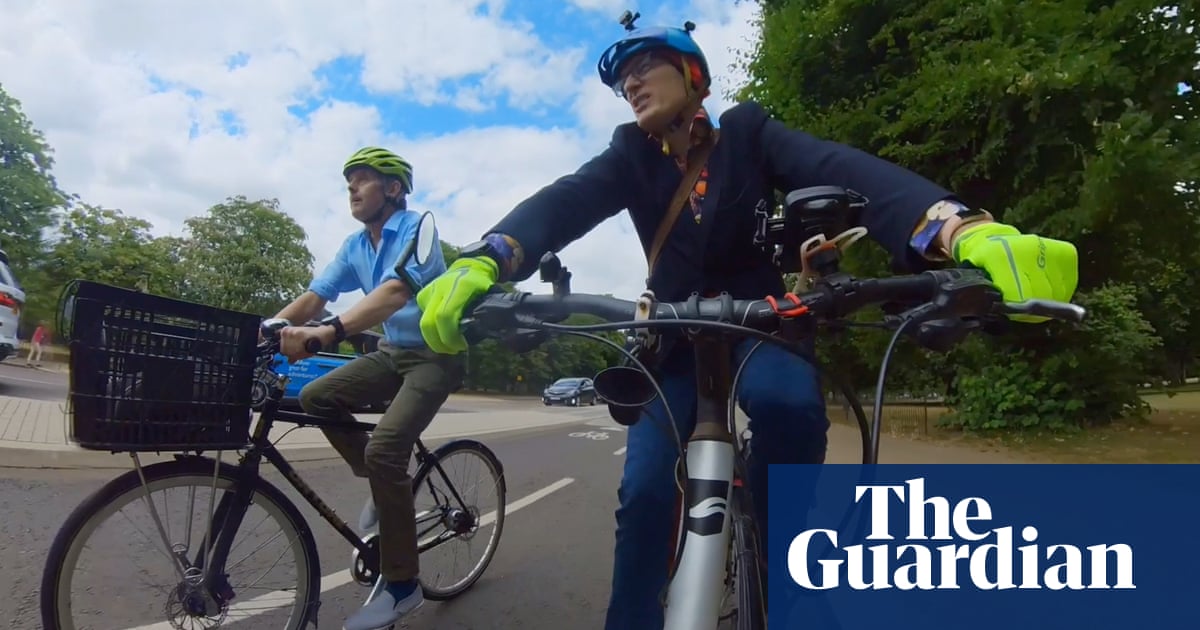On a sunny day in February three workers swept up the piles of ash left behind on an Altadena driveway from when the Eaton fire raged through the Los Angeles neighborhood the month before.
The flames of the blaze had consumed nearly every home on the street, leaving only brick chimneys and charred vehicles. Red signs at the entrances of properties warned in English: “Unsafe, do not enter or occupy … entry may result in death or injury.” Hazards such as lead paint, asbestos and batteries were strewn amongst the ashes, but few workers cleaning the neighborhood that day wore masks or other personal protective equipment (PPE).
Across the street, in the ashes of a home that had burned to the ground, Pedro Ramos, wore a thin blue medical mask as he picked up charred branches and placed them in a wheelbarrow. “The truth is that it’s toxic,” Ramos, who is from Guatemala, said in Spanish about the debris. “But it’s necessary to work to pay the rent and bills for my family.”
In the US, after climate disasters such as fires, floods and hurricanes, it is often immigrant workers who clean up and rebuild communities. In Los Angeles, it’s no different. In the burn zones of Altadena and the Palisades, many of the thousands of workers involved in clearing the debris from the megafires that killed 30 people and destroyed about 16,000 are from an immigrant background. Immigrants make up about 40% of the construction workforce in California, including hazardous materials removal. Those workers are particularly vulnerable while working in potentially hazardous conditions, say advocates.

On several visits to the Altadena burn zone in past months, it was clear that some workers involved in the cleanup had received training and PPE, but many others had not. Advocates say workers are not only risking their health, but they fear speaking out about conditions over concerns of wage theft and potential deportation amid stepped up immigration enforcement by the Trump administration.
As climate disasters become more common, immigrant workers are serving as “second responders”, said Nadia Marin-Molina, co-director of the National Day Laborer Organizing Network (NDLON), which supports immigrant day laborers across the US. “It’s impossible for me to exaggerate how much disaster response and recovery in this country relies on immigrant labor in this country,” she said.
Exploitative contractors
Los Angeles is under immense pressure to rebuild. LA was already experiencing a housing crisis before the fires, and rental and housing prices have skyrocketed since the disaster. The city is also in a hurry to recover before hosting a series of mega-events: the World Cup in 2026, the Super Bowl in 2027 and the Olympics in 2028.
Government officials are highlighting the speed of the cleanup. In February, the California governor, Gavin Newsom, and the Environmental Protection Agency (EPA) announced EPA workers had cleared more than 9,000 properties in just 28 days – the largest wildfire waste cleanup in the agency’s history.
Cleanup efforts following wildfires take place in different phases. The EPA is in charge of the first phase, in which dangerous materials like paint, cleaners and solvents, oils, batteries, pesticides, propane tanks and asbestos are removed. In the second phase, property owners have the choice to either allow the army corps of engineers to finish clearing their properties, or hire private contractors. As of 24 April, more than 1,700 property owners of about 12,000 eligible properties had opted out of the federal offer.


Bottom: an apartment unit being cleaned by volunteers from the Pasadena Community Job Center.
Photograph: Zaydee Sanchez/The GuardianFor homes left standing in burn zones, property owners hire private contractors to clean smoke damage and replace insulation in homes that survived the fires. For all types of work in the burn zones, employers are required to provide PPE and training. That’s because the debris can be highly toxic.
“There’s a really wide variety of materials [in the burn zones],” said Rachael Jones, an exposure scientist and professor in the UCLA Fielding School of Public Health’s environmental health sciences department. She said workers may be exposed to carcinogens like Polycyclic Aromatic Hydrocarbons (PAHs), formaldehyde, benzene, asbestos and harmful metals such as lead, arsenic, cadmium and chromium.
Soil testing has found dangerous levels of lead in and around the Eaton fire burn zone, likely from lead-based paint in the older housing stock in Altadena, according to the Los Angeles department of public health.
Soot and ash contain fine particles and toxic substances that can cause skin and lung irritation, shortness of breath, and exposure to carcinogens.
Without proper protection, workers risk long term breathing issues, lung scarring and cancer, said Jones. Their risk level depends on how long they are working in the burn zones, and what type of PPE they are wearing.
There is a spectrum of employers at the fire sites, and conditions for workers vary. The federal government has hired large contractors to carry out debris removal; those workers are properly trained and wear Tyvek suits and industrial-grade respirators.

But there is also a secondary industry that is bypassing the formal process; contractors are picking up immigrant day laborers from the corner near Home Depot and taking them to burn zones. They are less likely to receive training and PPE, she said. “They’re the ones that I’m most worried about, because it’s just completely uncontrolled. They’re really at the mercy of the people who bring them to the site.”
“[Workers] don’t necessarily have a formal employment arrangement, and that creates a lot of gray area about whose responsibility it is to ensure health and safety.” Jones said. “You end up with exploitative contractors.”
Nancy Zuniga, the director of the Workers Health Program at the Institute of Popular Education of Southern California, said workers at the LA burn sites told her their employers have not provided training or PPE.
One worker said she was taken with a group of people to a burn zone, Zuniga recalled. They weren’t given PPE and were asked to pick up debris and put it in trash bags. After she finished the job, her eyes became irritated and red from exposure to the debris. “And then she didn’t get paid,” Zuniga said.
Zuniga led a study on the experiences of hundreds of workers who were affected by the Woolsey fire, which raged in northern Los Angeles county in 2018. The study found workers developed rashes and breathing problems, faced wage theft, and felt pressure to stay on the job. What happened to workers during the Woolsey fire is now repeating at a larger scale, Zuniga said.
Lack of enforcement
Cal-Osha is the state agency responsible for regulating worker safety, but Jones, the exposure scientist at UCLA, said she was puzzled by the agency’s apparent lack of enforcement at the burn sites.
“These sites aren’t that big,” she said. “It’s not like you can’t drive through them in an afternoon and stop and look at what’s happening. Many of us are wondering why there hasn’t been a more aggressive approach to this?”
California’s department of industrial relations, which includes Cal-Osha, said it has participated in hundreds of outreach events and deployed teams to fire-impacted areas to reach homeowners and small-business contractors. The department said it is supporting worker rights and safety by providing $6m in funding to 21 community groups in Los Angeles through the California Workplace Outreach Project.

Employers are required to conduct worksite risk assessments, implement necessary safety measures, train workers to prevent exposure to hazards, and provide PPE, department spokesperson Denisse Gomez said. Employers engaged in fire debris removal must comply with title 8 of the California code of regulations, which outlines legal standards for workplace safety.
If a homeowner declines the offer of a no-cost, government-led cleanup, the homeowner or contractor is accountable for any issues that arise, such as permitting, environmental protections and worker safety, Gomez added.
“The Department of Industrial Relations (DIR) helps protect workers on the frontlines of disaster recovery – regardless of immigration status,” Gomez wrote in an email.
Some workers have received Osha training. On 13 March in Altadena, four men in Tyvek suits, goggles, masks and gloves cleaned a smoke-damaged apartment. The building was surrounded by the blackened debris of homes that had burned to the ground. But the workers knew how to protect themselves; they had received PPE and Osha training through the Pasadena Community Job Center.
Taking a break from cleaning, Cesar Saucedo said he knew workers who were picked up from a corner near Home Depot and taken to a burn zone but provided no training or PPE. “On the weekend, we went to a corner, where a group of workers were hired by a company for $17 an hour. They had no Osha training and the company gave them nothing,” he said in Spanish.


Bottom: volunteers in a home in Altadena.
Photograph: Zaydee Sanchez/The GuardianMarin-Molina, of NDLON, said that in the rush to recover, few employers take the time to train workers on the hazards they will encounter when cleaning up after climate disasters.
NDLON surveyed workers who cleaned up after Hurricane Ida hit New Orleans in 2021 and found that only 15% of day laborers working in hurricane-affected areas in New Orleans received required training. More than 90% reported wage theft while doing post-disaster recovery work. One study found that one in four workers who cleaned up after Hurricane Katrina were undocumented.
Marin-Molina explained that often it’s large national companies that hire day laborers through layers of subcontractors. The climate crisis has become lucrative for large disaster cleanup companies, who shield themselves from accountability by using subcontractors. “Under those layers, it’s the undocumented workforce that’s holding this all up,” Marin-Molina said.
Jones said the vulnerability of immigrant workers and lack of enforcement is nothing new. “It’s a longstanding uphill battle, and I think the fires are just making it more visible,” she said.

.png) 3 hours ago
5
3 hours ago
5













































